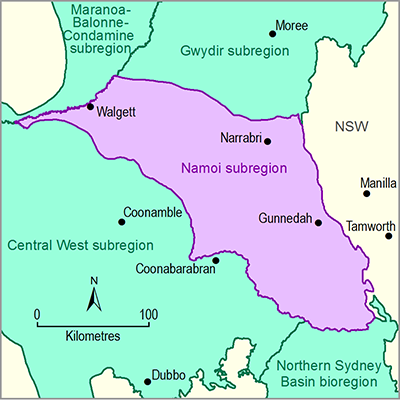- Home
- Assessments
- Bioregional Assessment Program
- Namoi subregion
- 2.3 Conceptual modelling for the Namoi subregion
- 2.3.1 Methods
- 2.3.1.2 Developing the conceptual model of causal pathways
This product presents the Assessment team’s conceptual understanding of how to model the causal pathway of coal resource developments on water-dependent assets in the Namoi subregion. A landscape classification represents the higher level ecosystems within which the water-dependent assets are located. The landscape classification has, through its mutually exclusive landscape classes (i.e. landscape classes do not spatially overlap), a complete spatial coverage of water-dependent assets in the subregion and provides the basis for an automated assessment of impact on these assets. Conceptually, the landscape classes are the impact-receiving surface layer that is connected through the different geological strata with the areas of coal resource development at depth and associated surface facilities.
Multiple lines of evidence form the basis for the conceptual models of causal pathways for the Namoi subregion. This evidence includes the existing information from Component 1: Contextual information on geology, hydrology and ecology of the subregion from the context statement (companion product 1.1 for the Namoi subregion (Welsh et al., 2014)), on the coal and CSG resource assessment (companion product 1.2 for the Namoi subregion (Northey et al., 2014)), and the water-dependent asset register for the Namoi subregion (companion product 1.3 for the Namoi subregion (O’Grady et al., 2015)). They feed into key system components and interactions for the geology, hydrogeology and surface water of the subregion (Section 2.3.2), ecosystems (represented in landscape classes) (Section 2.3.3), and the CRDP (Section 2.3.4). Section 2.3.5 then details the causal pathways for baseline and CRDP based on a hazard analysis.
A detailed hazard analysis determines the level and scope of potential impacts from the coal resource development that may elicit responses in the subregion’s surface water and groundwater resources, thus conceptually linking coal resource development activities with potential changes in surface water and groundwater. Linking these coal resource development activities at depth with responses of the hydrology at the land surface (represented as the subregion-specific landscape classification) provides the conceptual understanding of potential causal pathways from coal resource development on water-dependent asset locations. In this context, the conceptual model of causal pathways also considers changes to surface-connected groundwater to incorporate any potential groundwater dependency of the landscape classes. The causal pathways are related to the baseline and CRDP. They provide the Assessment team’s current understanding of the potential pathways to impacts that are likely to occur from the existing and future coal resource developments in the Namoi subregion.
This product also provides a broad conceptual understanding of how the Namoi subregion functions in relation to potential future coal resource development impacts on surface water and groundwater. It takes into account existing knowledge on the hydrology of the subregion, and provides the opportunity to reduce the preliminary assessment extent to a ‘first cut’ footprint of potential coal resource development impacts on water based on the geographic zones of the Namoi subregion (see Section 2.3.5).
The reduced footprint and the causal pathways form the basis for the subsequent product 2.7 (receptor impact modelling). This product incorporates the combination of the Namoi subregion-specific landscape classification and the hydrological estimates from the surface water and groundwater modelling (companion product 2.6.1 (Aryal et al., 2018) and companion product 2.6.2 (Janardhanan et al., 2018) for the Namoi subregion), and uses hydrological response variables and receptor impact variables to identify impacts to landscape classes and water-dependent assets.
Information and knowledge gaps relevant for the developed conceptual models of causal pathways are addressed in Section 2.3.5.

Product Finalisation date
- 2.3.1 Methods
- 2.3.2 Summary of key system components, processes and interactions
- 2.3.3 Ecosystems
- 2.3.4 Coal resource development pathway
- 2.3.5 Conceptual modelling of causal pathways
- Citation
- Acknowledgements
- Currency of scientific results
- Contributors to the Technical Programme
- About this technical product
